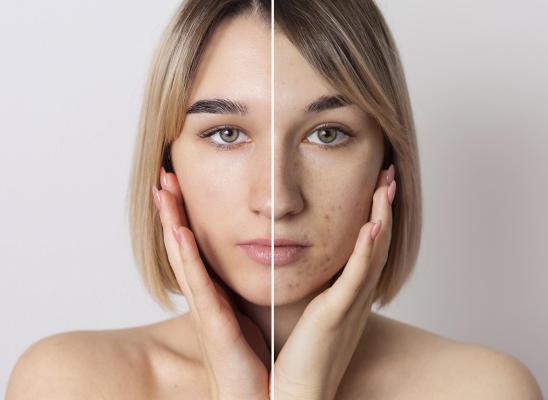Emotional Regulation: The Cognitive Underpinnings of Skin-Picking Behavior

Online test
Find out the severity of your symptoms with this free online test
Most people have on occasion engaged in nail-biting or even picked at a scab a little too much. But sometimes, these behaviors become too frequent and the urge too much to resist. Why does that happen?
Habitual nail-biting, hair pulling, and skin picking are collectively referred to as body-focused repetitive behaviors (BFRBs). These actions are recurrent, problematic, destructive behaviors directed toward the body and are thought to be triggered by some unpleasant emotional state. Many people engage in these behaviors from time to time (e.g., nail-biting) but do so at subclinical levels that create little or no functional impairment. For some people, they can manage their emotional triggers and responses in healthy, non-injurious ways. For others, however, their emotional responses somehow get misdirected and the result is destructive body-focused behaviors like skin-picking and hair-pulling.
How that works isn’t exactly clear and researchers have turned to various psychological models to try and understand how and why BFRBs occur. What seems to be clear is that these behaviors seem to emerge in response to emotional triggers and serve to help alleviate emotional distress.
A comprehensive review of the literature suggests that BFRBs are the result of a maladaptive emotional response, also known as emotional dysregulation, supporting the viewing of BFRBs through the lens of an Emotional Regulation (ER) Model.
Emotional Regulation and the ER Model
Emotional regulation refers a person’s ability to effectively manage and respond to emotional experiences. In other words, it’s maintaining control over one’s emotions and response. People use strategies for regulating emotions all the time. For example, to manage stress, you might practice deep breathing or start a yoga program. These are ways of responding and managing an emotional state in an effective way.
Research suggests that for people with BFRB’s, like skin picking, their ability to regulate their emotions effectively is impaired resulting in emotional dysregulation. Emotional dysregulation (ED) is the inability to respond to and manage emotions effectively. It involves the repeated use of strategies to regulate emotions that may be effective in the short term but ultimately result in further emotional and physiological distress or contribute to physical, personal, or psychosocial distress.
The emotional regulation (ER) model holds that people with skin-picking and other BFRBs have deficits in their emotional regulation and, as a result, respond to distress in ways that relieve the emotional distress and also reinforce the behavior. In other words, they engage in behaviors that, for the moment, alleviate the distress. However, the response doesn’t solve or alleviate the underlying trigger. When the trigger comes again, the response, in this case, skin picking, is the same. Although the skin-picking causes distress, it is maintained by both negative (relief) and positive (stimulation) reinforcement. Over time, what was initially a quick reliever becomes a problematic or maladaptive behavior pattern. The skin-picking becomes part of a habitual response pattern that repeats.
Some of the deficits in emotional regulation that have been suggested as playing a role in skin-picking and other BFRBs include alexithymia, maladaptive emotional reactivity, experiential avoidance, and response inhibition.
Studies have found that people affected by skin-picking showed higher levels of alexithymia than people who are not affected. Alexithymia is a personality trait characterized by an externally-oriented cognitive style that impairs one’s ability to identify their own feelings and limits their capacity for introspection.
Maladaptive emotional reactivity refers to abnormally heightened (hyperreactivity) or dampened (hyporeactivity) sensitivity to certain emotions. People affected by skin-picking tend to experience higher levels of emotional reactivity than those unaffected.
Experiential avoidance is the unwillingness to experience distressing internal phenomena, like emotions. Research has found that people affected by clinical skin picking reported higher levels of experiential avoidance than people who were unaffected by skin picking.
Response inhibition is the ability to inhibit a response when distressed or refrain from responding if it impacts a future goal. Persons affected by clinical skin-picking tend to have greater difficulty with response inhibition when distressed than people who were unaffected by skin-picking.
The Link Between Personality, ER, and Skin-picking
Personality traits and their impact on emotional regulation have also been studied. Scientific and anecdotal evidence suggests that there are different phenomenological dimensions or subtypes of skin-picking.
Looking closer, researchers have examined the impact that certain personality traits can have on emotional regulation and skin-picking behavior. Automatic skin-picking was moderately associated with avoidant, masochistic, and borderline traits. It was weakly associated with depressive, dependent, negativistic, and schizotypal traits. Some of these traits have been associated with emotional dysregulation. Individuals with higher levels of automatic skin-picking also showed deficits in their ability to engage in goal-directed behaviors. This is in keeping with other research that has shown that personality traits such as novelty-seeking and self-directedness were predictors of skin picking behaviors.
What Emotional Regulation Means for Treatment
If Emotional Dysregulation is at the heart of these repetitive behaviors, as the ER model suggests, then interventions to “reset” one’s ability to manage emotional responses seem to make sense. In fact, a 2018 study sought to examine that very idea.
Using a strategy called cognitive reappraisal, the study sought to examine the impact of cognitive reappraisal on skin-picking along certain personality trait dimensions of novelty seeking and self-directedness. Skin-picking behavior was decreased in participants with certain personality traits including low to moderate novelty-seeking. These individuals tend to not need new, external stimuli and tolerate monotony well, possibly placing them at greater risk for developing skin-picking behaviors. This study exemplifies the need to be informed of the roles that personality and ER play in skin-picking behaviors when making treatment decisions.
While there is no definitive therapeutic approach to treating skin-picking, current treatments consist primarily of psychotherapy and sometimes, medication. A number of therapeutic approaches have shown some efficacy in treating skin-picking including Cognitive Behavioral Therapy (CBT) and Habit Reversal (HRT). HRT has shown to decrease picking and decrease skin damage. CBT, in particular, has shown to be particularly effective not only in reducing skin-picking behavior but also in reducing the dysfunctional cognitions associated with skin-picking.
Other acceptance-based therapies have shown some efficacy in reducing skin-picking behaviors as well. Research has shown that therapeutic approaches such as Acceptance and Commitment Therapy (ACT), ACT-enhanced (AEBT), and Dialectical Behavior Therapy (DBT) can be effective in reducing the severity and impairment of BFRB behaviors. It is thought that these approaches improve the individual’s emotional regulation skills and, as a result, reduces maladaptive behaviors.
Regardless of the specific approach, some strategies have shown a positive effect on reducing picking behaviors. These strategies involve some mechanism for moderating behavior while also strengthening emotional regulation skills. These are generally strategies that might be part of an overall therapeutic intervention.
Cognitive Reappraisal - Cognitive reappraisal is the ability to recognize and reinterpret emotional events to change one’s emotional reaction to the trigger event. Reappraisal has been shown to reduce skin-picking in some individuals and personality types.
Stimulus Control – This strategy involves making changes in your environment that make it harder to pick.
Urge Suppression – Skin-picking can be triggered by intense urges to pick that can create distress. Increasing one’s distress tolerance can help the individual learn to better manage urges.
Response Inhibition – People affected by skin-picking have difficulty suppressing the maladaptive picking response to an emotional trigger. Response Inhibition training has been shown to reduce the frequency and intensity of BFRBs.
While so much about skin-picking is still not well-understood, research continues to uncover new pieces to the clinical picture. The answer to understanding this and other BFRBs is not an either/or but a both/and approach. These behaviors have both behavioral and cognitive/emotional components that highlight the need to consider individual traits and differences when making treatment decisions.
Resources
- Roberts, S., O'Connor, K., & Bélanger, C. (2013). Emotion regulation and other psychological models for body-focused repetitive behaviors. Clinical Psychology Review, 33(6), 745-762. https://www.sciencedirect.com/science/article/abs/pii/S027273581300072X
- Alexander, J. R., Houghton, D. C., Bauer, C. C., Lench, H. C., & Woods, D. W. (2018). Emotion regulation deficits in persons with body-focused repetitive behavior disorders. Journal of Affective Disorders, 227, 463-470. https://pubmed.ncbi.nlm.nih.gov/29156359
- Roberts, S., O'Connor, K., Aardema, F., Bélanger, C., & Courchesne, C. (2016). The role of emotion regulation in body-focused repetitive behaviours. The Cognitive Behaviour Therapist, 9, E7. https://www.cambridge.org/core/journals/the-cognitive-behaviour-therapist/article/abs/role-of-emotion-regulation-in-bodyfocused-repetitive-behaviours/8E267245687F7D75A63ED2B2214482D1
- Snorrason, Í., Smári, J., & Ólafsson, R. P. (2010). Emotion regulation in pathological skin picking: Findings from a non-treatment seeking sample. Journal of Behavior Therapy and Experimental Psychiatry, 41(3), 238-245. https://doi.org/10.1016/j.jbtep.2010.01.009
- Pozza, A., Mazzoni, G. P., Patassini, I., Berardi, D., Molinaro, F., Parenti, G., & Dèttore, D. (2016). Milwaukee inventory for the dimensions of adult skin picking--italian version. PsycTESTS Dataset. doi:10.1037/t52632-000
- Pozza, A., Giaquinta, N., & Dèttore, D. (2016). Borderline, avoidant, sadistic personality traits and emotion dysregulation predict different pathological skin picking subtypes in a community sample. Neuropsychiatric disease and treatment, 12, 1861–1867. https://doi.org/10.2147/NDT.S109162
- Prochwicz, K., Kłosowska, J., & Kałużna-Wielobób, A. (2018). The relationship between emotion regulation strategies, personality traits and skin picking behaviours in a non-clinical sample of Polish adults. Psychiatry research, 264, 67-75.https://pubmed.ncbi.nlm.nih.gov/29627699/
- Kłosowska, J., Prochwicz, K., & Kałużna-Wielobób, A. (2019). The relationship between cognitive reappraisal strategy and skin picking behaviours in a non-clinical sample depends on personality profile. Journal of Obsessive-Compulsive and Related Disorders, 21, 129-137. https://www.sciencedirect.com/science/article/abs/pii/S2211364918302008
- Lee, H., Espil, F. M., Bauer, C. C., Siwiec, S. G., & Woods, D. W. (2018). Computerized response inhibition training for children with trichotillomania. Psychiatry Research, 262, 20-27. doi:10.1016/j.psychres.2017.12.070 https://epublications.marquette.edu/cgi/viewcontent.cgi?article=1328&context=psych_fac
Online test
Find out the severity of your symptoms with this free online test
Start your journey with SkinPick
Take control of your life and find freedom from skin picking through professional therapy and evidence-based behavioral techniques.
Start Now



